and Silvio Mazziotti1
(1)
Department of Radiological Sciences, University of Messina, Messina, Italy
Abstract
Orthopantomography is a radiographic technique, allowing to achieve panoramic radiograms which are able to demonstrate anatomical complex structures. It includes not only dental arches but also paranasal sinuses, superior and inferior maxillaries and temporomandibular joints. This chapter generally illustrates technical and methodological problems. Indeed, as orthopantomography is a complex methodology, it suffers from numerous limitations which can interfere with the diagnosis: operator’s errors, patient’s artefacts and artefacts generated by machine intrinsic characteristics or by its malfunctioning.
Orthopantomography (OPT) is the most widespread radiographic investigation carried out today. It represents an extraoral study technique in which both revelation system and radiogenic source are external to the oral cavity.
OPT is a radiologic examination which allows to accurately plan odontoiatric treatment in a remarkable number of cases. Indeed, the methodology is able to provide complex data on the masticatory apparatus and the surrounding structures allowing the evaluation of normal anatomy and the majority of pathological conditions. Orthopantomography is also called panoramic radiography of dental arches. The term orthopantomography comes from the Greek words: ορθος (“ortós”: orthogonal) = radiant beam perpendicular to the teeth major axis, παν (“pán”: all) = global vision of both arches and τομος (“tómos”: cut, section) = radiological technique able to generate section images (tomography), a methodology known in traditional radiology also as stratigraphy. It exploits the cancellation principle through the kinetic blur of the structures beyond the interest area.
Consequently, panoramic radiography’s hardest challenge is to transfer the aforementioned anatomical structures into a bidimensional radiological image. Those images are characterised by correct parameters of exposition and by the minor rate of structure superimposition and geometrical distortion. There is no doubt that this goal is not easy to achieve when considering the extreme variability of patient’s morphology and structure thickness taken into examination. Moreover, innumerable individual differences among the whole population have to be considered. OPT is based on the simultaneous employment and integration of two basic principles which derive from traditional radiology: tomography and fissure radiography.
Tomography is a technique which consists in a synchronous and integral movement, occurring in opposed directions, of radiogenic source (radiogenic tube) and revelation system (radiographic film or digital detector), around a mechanically fixed point, called rotation fulcrum, which identifies the interest area (tomographic plane).
The tube detection system movement gives rise to structures’ cancellation beyond the interest area (both in front and behind). This is the result of kinetic blur or movement blur optical phenomenon. In OPT, such movement is realised with arch trajectories at about 200–240° (Fig. 1.1).
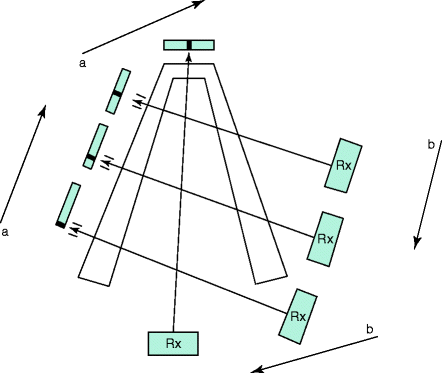

Fig. 1.1
Diagram illustrating the stratigraphic translation of the tube detection system in OPT. The arrows marked a indicate the movement of the revelation system; arrows marked b indicate the tube movement which occurs in opposed direction. The diagram represents the acquisition of a single hemi-arcade and the frontal region. Rx X-ray source
As a consequence of what was aforementioned, a clear representation of all anatomical structures included in the tomographic plane is realised. The representation is radiographically optimal, as it is ‘in focus’. This is possible as the system rotation fulcrum corresponds to the structure of interest, which, during the tube detector translation movement, appears optically still. Thereby, they are better radiologically representable than what is situated beyond the tomographic plane, which will be blurred and therefore deleted. The cancellation phenomenon turns out to be only partial. Indeed some structures, even if out of the interest plane, can interfere with the final image, generating the so-called parasite images or images of transport. This is due to their high density or radiolucency and/or their close anatomical contiguity to the area of interest.
It is more to say that, in linear tomography, the thickness layer varies depending on the ‘oscillation angle’ (major angles generate thinner layers whereas minor angles determine thicker layers).
The principle of tomography applied in OPT is obviously adapted to the need of representing curvilinear morphology structures, such as dental arcades. Indeed, OPT mainly exploits, not only one rotation fulcrum (as it happens in normal linear tomography) but three rotation fulcrums (one for each lateral arcade and one for the central elements’ representation). Angular movement of the tomographic system creates a minor angle to represent lateral arcades (characterised by major thickness), while it performs a major angle to represent frontal elements (which present minor thickness).
Thereby, this technical peculiarity allows to adapt the thickness of the tomographic plane to different thicknesses which characterise maxillaries’ various portions.
Therefore, the tomographic movement articulated in three fulcrums generates a section plane with variable thickness which can be quantified in about 15–16 mm for lateral sectors analysis and about 8–9 mm for the study of thinner structures characterising the frontal part of the dental arcades (Fig. 1.2).
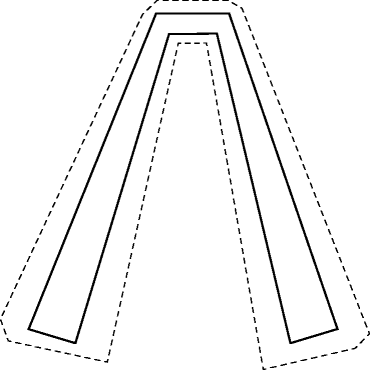

Fig. 1.2
The dashed line indicates the layer thickness which is thicker at the level of the lateral maxillaries and thinner in the region of the frontal elements
Tomographic systems with variable geometry rotation fulcrum are the most technologically advanced pieces of equipment, performing well in image quality. They do not employ fixed rotation fulcrums, but realise a unique fulcrum continuous variation along a prefixed elliptical trajectory.
Those tools allow to operate, according to the case, using different elliptical trajectories which are adaptable in different needs (paediatric age, jaws’ malformations, etc.)
OPT system rotation time, and therefore image acquisition time (independently on the type of technology used), varies from about 15 to 20 s.
Fissure radiography or scanography represents the other OPT technical peculiarity.
It entails the use of a fissure collimator (from which fissure radiography takes its name) aiming at eliminating the radiation beam oblique component.
This artifice reduces the photon beam into a thin sheet, hitting selectively the single dental alveolus elements. The relative image is gradually impressed on a thin layer of the film. Such image is deprived of any deformations and has a minor diffuse radiation.
This procedure is possible thanks to the tube and the collimator synchronical movement. As a consequence, the revelation system (radiographic film or digital plate) is progressively impressed.
The digital revelation system or radiographic cassette, beyond the already translation movement described above, will obviously have a running capacity articulated in autonomous micromovements. As a consequence, always different points of the revelation system detection plane will be exposed to the photon layer.
Methodology
The following paragraph generically illustrates technical and methodological problems, as it is impossible to fully analyse the peculiarity of the numerous equipment typology present in the market today.
A particular preparation of the patient is not requested in order to carry out a correct OPT examination; however, it is absolutely necessary to remove all that can disturb the final image (earrings, dentures, hairpins, piercing, etc.)
A fundamental methodological artifice entails the insertion of a removable clamp between the central incisors margin. This allows the elements of superior and inferior arcades to be placed in the same line and in vertical position. As a consequence, they completely fall into the tomographic plane, giving rise to an optimal radiological representation.
It is very clear that excessive inclination of incisive elements or errors in the head collocation make those dental elements fall entirely or partially out of the tomographic plane. This gives rise to a deficient representation of the apical region or the crown and sometimes of both structures (Figs. 1.3, 1.4, and 1.5).
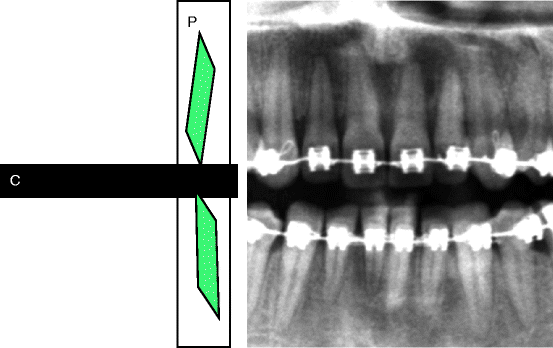
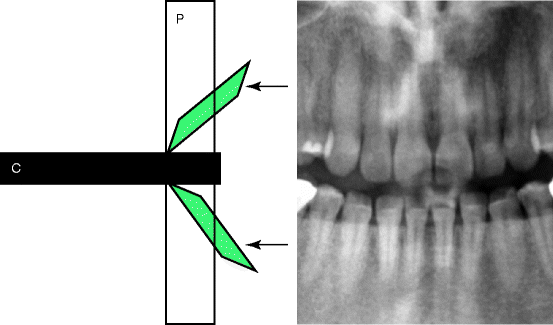
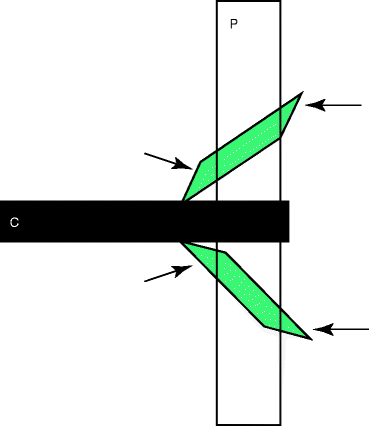

Fig. 1.3
The image shows the correct position of the incisive elements in the tomographic plane. The radiographic representation shows that the incisive elements are perfectly in focus, both at apical and crown level. P plane, C clamp

Fig. 1.4
Excessive inclination of the incisive elements makes the apices (represented by arrows) fall out of the tomographic plane. Therefore, they appear scarcely defined as they are not ‘in focus’. This is visible in the radiographic representation. P plane, C clamp

Fig. 1.5
A major inclination of the incisive elements or the wrong positioning of the tomographic plane can give rise to a deficient representation of the incisive elements’ apical region and crown (the incisive elements are indicated by arrows) P plane, C clamp
Moreover, it will be necessary to place the head on a provided base or submental support plane, to accurately regulate the height of the cassette support and establish the head position.
The submental support is obviously essential for edentulous patients in whom the removable clamp cannot be used. Three linear luminous reference lines regulate head positioning. The first line is in the horizontal plane and has to be aligned with the Frankfurt plane. Another line is vertical, in order to identify the midsagittal plane. The latter, which is vertical too, is situated on the lateral surface of the patient’s face, which must coincide with the canine–incisive region. Finally, such line will determine the position of the frontal group elements in respect to the tomographic plane (Fig. 1.6a, b).
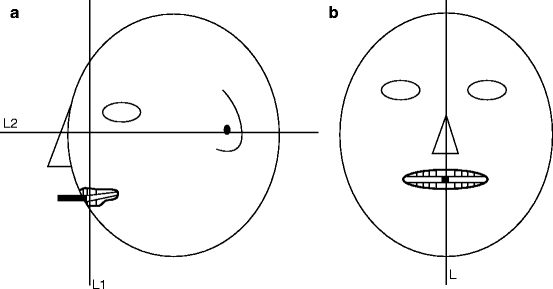

Fig. 1.6
(a) The lateral positioning is achieved by two luminous reference lines. L1 corresponds to the tomographic plane, referring to the frontal group elements. L2 represents the horizontal plane which must be aligned with the Frankfurt plane. (b) Positioning on the sagittal plane implies the use of a luminous reference line which divides the patient’s face in two symmetrical halves. L luminous reference line
This coincidence will be obviously realised, case by case, with appropriate linear adjustments of the position and the removable clamp.
It is fundamental to invite the patient to close his lips and to push his tongue against the hard palate (in order to eliminate the artefacts deriving from aerial content which is comprised between the tongue and the palatal arch).
In addition, it will be appropriate to explain the examination modality and length to the patient, inviting him to stand still for the whole time.
It is not advisable to use proteximetric devices for the neck, as their artefacts can sometimes cause the examination repetition. Finally, in order to have a correct OPT execution, it will be necessary for the patient to catch the apposite support with his hands, to bring together his feet in front of the body and to keep the incisors attached to the clamp.
This posture (also called the position of the ‘water skier’) aims at withdrawing the cervical spine, moving it away from the rotation fulcrum and the detection plane. This artifice determines the minimisation of the noise, due to the transport shadow of the cervical spine on the final radiogram (Fig. 1.7).
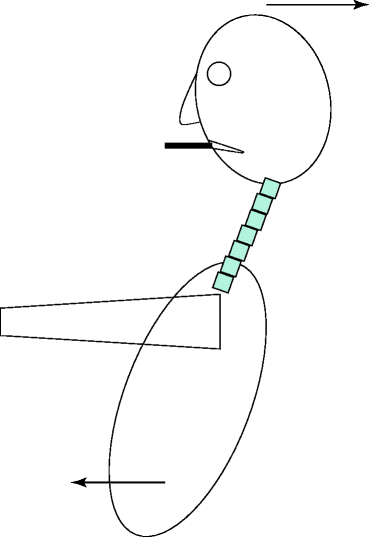

Fig. 1.7
Schematic diagram which describes the position of the ‘water skier’. The body anteropulsion and the head retropulsion determine the withdrawal of the cervical spine
Stay updated, free dental videos. Join our Telegram channel

VIDEdental - Online dental courses


